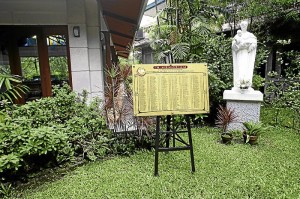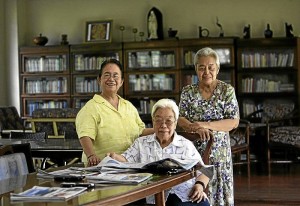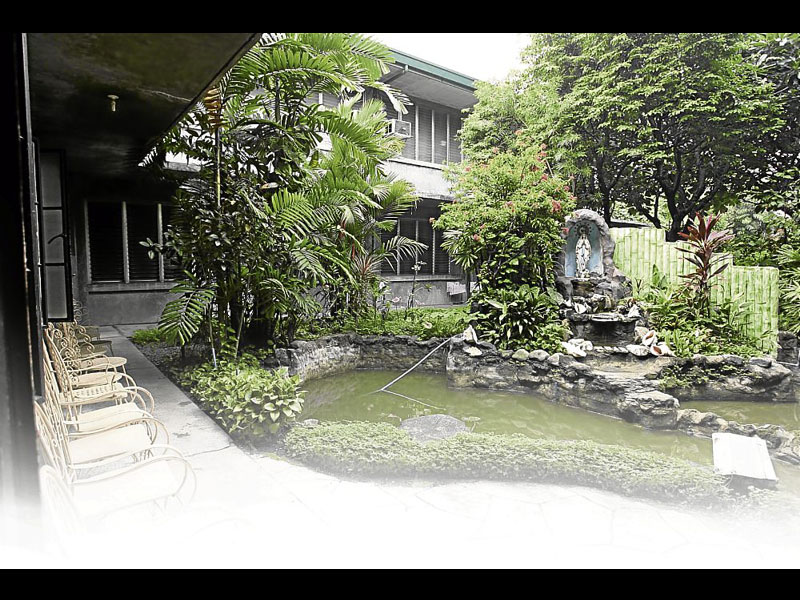 Retirement homes for members of religious congregations are generally regarded as the “last stop before heaven.” For the ICM sisters at the Queen of Peace Convent in Quezon City, the layover is welcome.
Retirement homes for members of religious congregations are generally regarded as the “last stop before heaven.” For the ICM sisters at the Queen of Peace Convent in Quezon City, the layover is welcome.
The convent sits on an edge of the ICM compound in Sta. Mesa Heights, a lot five blocks large with frontage on four streets. It faces Banawe Street, while St. Theresa’s College-Quezon City faces D. Tuazon.
Around 60 sisters can be accommodated at Queen of Peace. The criterion for entrance is state of health, not age. There, the seriously ill can avail themselves of emergency medical facilities and care provided by a team of five caregivers with an additional one on-call, and two nurses on round-the-clock basis. The medical team is headed by an ICM sister-nurse, Sr. Josephine Ong, who trained at the University of Santo Tomas College of Nursing, then performed medical service mission in Burundi.
On the ground floor past the entrance hallway are the main reception area, multipurpose room, an ample recreation room, the garden chapel, refectory, kitchen and infirmary. The first and second floors house the private quarters of the resident sisters. Behind are annexes that house a Wellness Center and even a salon.
What gives life to this pocket of humanity is the spirit that defines the ICM identity, framed in their own words: “foremost, combining Deep Interior life with undaunted Apostolic Zeal in our silence, stillness, suffering, relationship, individual and communal prayer, and drawing our strength from the Spiritual heritage of Mother Foundress, St. Augustine and Mary.”
Here are four of the sisters at Queen of Peace.
Sr. Sonia Osmeña
Sr. Sonia Osmeña, with the support of her management council, has been overseeing infrastructure and operations as superior of Queen of Peace since June 2009. She earned an AB-BS Education degree from St. Theresa’s College-Cebu, double major in history and religious education.
 The call to enter the convent became compelling when she was a college junior. The girl from a socially and politically prominent clan in Cebu entered the St. Therese Novitiate in Pacdal, Baguio City, in 1962, and professed her vows in 1965.
The call to enter the convent became compelling when she was a college junior. The girl from a socially and politically prominent clan in Cebu entered the St. Therese Novitiate in Pacdal, Baguio City, in 1962, and professed her vows in 1965.
She was first assigned as religion coordinator at STC Cebu. Before coming to Queen of Peace, she was at the St. Francis Academy in Balamban, Cebu, where she was responsible for religious/Christian Living formation of the lay teachers, directress, principal and students.
When the idea of heading the Queen of Peace operations was broached to her last year, she had to do a lot of discernment. All the related training she had was a course in clinical pastoral education at Silliman University in Dumaguete. Eventually, she realized the new assignment was another form of mission, though “I did not know what I was getting into,” she says.
Luckily, she has a basic inclination towards nurturing and healing, extending to an interest in alternative medicine. Her familiarity with Ayurvedic, pranic and distance healing methods helps. Before assuming her post in Manila, she took an intensive individual training program in geriatrics with one of Cebu’s prominent gerontologists.
It is presumed that running a retirement home for religious should be a lark, precisely because it is populated by people who have publicly vowed obedience. In the Western context, not quite. Because of dwindling vocations, retirement homes for religious in the West are emptying fast and being sold one by one. The few remaining residents are sent off to government-owned homes for the aged.
A few have rebelled; just recently, there was news of two octogenarian sisters in France who ran away.
The problem of funding likewise besets retirement homes for religious in the Philippines. The ICM motherhouse is no longer able to finance the care of the sisters entirely. They do get a pension from their congregation, but it is not enough to cover the full cost of medical care. To a certain extent, therefore, the Queen of Peace Convent is dependent on donations, whether in cash or in kind. Sr. Sonia works and prays harder than ever these days.
Sr. Salve Vedar
 Sr. Salve exudes the positive image of a religious sister: composed, dutiful, gentle and socially aware. She has been teacher and superior in her peripatetic career through myriad work assignments. Nuns of her generation show a staying power, perhaps grounded in the basic disposition, aptitude and eight years of solid training through postulancy, novitiate, profession of temporary vows, and, finally, profession of perpetual vows.
Sr. Salve exudes the positive image of a religious sister: composed, dutiful, gentle and socially aware. She has been teacher and superior in her peripatetic career through myriad work assignments. Nuns of her generation show a staying power, perhaps grounded in the basic disposition, aptitude and eight years of solid training through postulancy, novitiate, profession of temporary vows, and, finally, profession of perpetual vows.
Before the Second World War, the novitiate was in Heverlee, Belgium, but in 1945 the novitiate in Pacdal, Baguio, was opened.
Teodora Vedar of Silang, Cavite, naturally gravitated to the ICM sisters because they were the teachers she knew at her town’s Infant Jesus Academy. Since it had no high school, she transferred to Malate Catholic School in Manila. From there, she proceeded to UST for her BS Education. She never forgot the sisters at Infant Jesus Academy, however, and a year and a half after college, she decided to join the ICM. As a religious, she took the name Salvacion.
Alas, her congregation does not impose the vow of stability on its members. Sr. Salve moved around the missions 25 times, teaching science and religion. She stopped teaching when she became a principal, then retired at Queen of Peace when the strength of her teacher’s voice and energy level gave out.
At Queen of Peace, the former principal and school superior takes care of the reception desk on certain days of the week. At other times, she assists in some activities outside the convent. Her days are spent in prayer and recollection, and that is enough.
Sr. Rose Marie Iñigo
Sr. Rose Marie Inigo is a singing nun—a music graduate, major in piano and minor in voice. “My father dreamed of me performing on the stage of La Scala de Milan. Instead, I landed in La Scala de Pacdal,” she says.
 Music only? Some people have disdainfully reacted to her academic background that way, says Sr. Rose. But it is about God, above all, with music as her prayer.
Music only? Some people have disdainfully reacted to her academic background that way, says Sr. Rose. But it is about God, above all, with music as her prayer.
Talking to Sr. Rose almost feels like being in a musical or Bollywood movie. As she recalls highlights in her life, at intervals she breaks into song associated with each memory. She runs the gamut, from the Student Catholic Action battle cry (“An army of youth flying the standard of truth…”) to the lyric-less Vatican or papal anthem that all Theresians heard at special flag ceremonies (played on pipe organ, not brass), to “No Mas Amor Que El Tuyo,” sung at the First Eucharistic Congress, and the Flemish hymn “How Good You Are Oh Lord—Wat Zigt Gegoed, O Heer.”
As a little girl at St. Scholastica’s College, where she had a classmate named Corazon Cojuangco, Rose Marie was part of the Glee Club, singing in three voices, as the arrangement required, though not all at the same time, of course.
At STC Manila, she was active in school dramas under Sr. Adolphine and the Glee Club under Sr. Magdalene. Her family later relocated to Davao City, where she became the first graduate of the Fernandez Piano School. She taught at the school after graduation.
Music is in Sr. Rose Marie’s genes. A grandfather led a family band. Her siblings joined the Bayanihan Dance Troupe. She would have signed up with them, but the year they did, 1958, she entered the St. Therese Novitiate.
Her assignments as religion teacher, music directress and choir coordinator led her from STC-QC to Christ the King College in San Fernando, La Union, then Holy Family Academy in Baguio City, and St. Teresita’s School in Lubuagan, Kalinga. Apart from teaching music in ICM schools, a highlight of her career as missionary is the 13 months in 1987-’88 that she spent attending to senior citizens and the mentally challenged in Lebanon (which had an ICM presence up to 1995). For that, she had to go to Belgium to polish her French.
Her last active stint before her retirement was in Carrascal, Surigao del Sur, from 2005-2008, doing pastoral work among fisherfolk.
As a retiree, Sr. Rose Marie’s life continues to be filled with people and song. She sees her brothers Nonong and Jun (another is in the US), her younger sister, Lina Winebrenner, and her STC classmates at frequent, joyful reunions. As she breaks into a Flemish song, “Wat Zigt Gegoed, O Heer-How Good You Are, O Lord,” you know she means every word of it.
Sr. Ramona Mendiola
Sr. Ramona Mendiola, the first Filipina superior general of the ICM, is aware that many take a dim view of her spearheading the abolition of STC’s college department in Quezon City. (It had been transferred from Manila to Quezon City in 1966.) It was a college department noted for academic excellence and the distinction of its graduates.
 Sr. Ramona forged through successfully, and now she rides the elephants of memory, staying active in retirement.
Sr. Ramona forged through successfully, and now she rides the elephants of memory, staying active in retirement.
Admired as a student leader at STC Manila in the 1940s, Lourdes (her real name) Mendiola taught soon after graduation but entered the ICM novitiate in Pacdal in 1951.
Following her profession of vows in 1954, she was assigned to teach at St. Theresa’s Cebu and, four years later, became its principal. She left Cebu to work for a master’s degree at St. Louis University in Baguio, returning to Cebu afterwards to become dean of STC’s College Department. She quickly became, in succession, dean of STC Quezon City’s College Department, member of the Provincial Council in the Philippines, district superior, and then in 1973 was elected member of the General Council in Rome.
Seven years later, she was elected ICM superior general based in Rome—in today’s parlance, head honcho of the ICM. It was a position she held for 12 years.
After a one-year sabbatical, she flew to Taiwan to be what she joined the ICM for—a missionary. She stayed in Taiwan from 1993-2008, when at age 80 she felt her body telling her it was time to go home. She has been at Queen of Peace since February 2008.
Try as one might, one cannot gloss over the closure of STC’s College Department. Sr. Ramona speaks with conviction about her rationale for it. The root of the congregation’s existence is mission, specifically focused on the poor. Though Mother Foundress’ background had been in the education of the elite in West Flanders, Belgium, her dream, her vision was to work among the poor in non-Christian lands.
As head of the congregation for 12 years, Sr. Ramona had to nudge mindsets from their tight moorings, oriented as they had been for centuries towards a hierarchical model. She does not recall encountering any particular difficulty in managing a multiracial, multicultural organization that at times numbered more than a thousand members.
What helped was that she has always had a universal outlook, a quality which enabled her to lead the ICM through its agenda of change during one of the stormiest periods in Church history.
At Queen of Peace, Sr. Ramona does not have special tasks. She gave up her electric typewriter in 2004, so she does her letter writing in longhand. She does a lot of reading, lately the writings of Pope Benedict XV which she appreciates for their profundity. She also takes the time to read the newspapers, but does not watch TV. She enjoys the company of her fellow sisters and makes time to serve as sounding board for those who relate their concerns to her.
Lately she has been allocating more time for family activities. She also sees former students, classmates and personal friends.
Queen of Peace is a place Sr. Ramona wanted to go to. At the height of her busyness, she used to stay there because it was where her peers were. When she came home for good, they were still there. But no longer now.
“The trouble is,” she says good-humoredly, “I never realized they would die ahead of me.”
A day in the life
Sr. Jo Olmedo smiles graciously as, an hour before noon, she picks her way carefully to the large main parlor where her fingers make the piano keyboard sing with Buencamino’s “Ang Larawan.” Resting elsewhere is Sr. Delia Coronel who, Frankie Sionil José says, “has not been accorded the honor she deserves” for translating the Darangen epic of the Maranaw into English, several volumes that will now endure for future generations of Filipinos. Sr. Rose Marie Iñigo breaks into bars of “Wat Zigt Gegoed, O Heer.” And Sr. Sonia Osmeña is bustling about attending to the needs of the community.
One comes away from Queen of Peace persuaded that here are lucky souls who have found their joy.









































